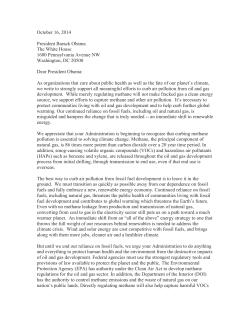
Fact Sheet - California State Assembly, Democratic Caucus
Assemblymember Tony Thurmond, 15th Assembly District AB 1496 – METHANE EMISSIONS ISSUE California is an established leader in cutting edge climate policy. From the renewable portfolio standard to the first-of-its-kind cap-and-trade carbon reduction system, California has pioneered policies to reduce human and industrial impacts on the climate and our environment. However, the state has not yet established comprehensive policies or monitoring systems to regulate methane emissions, a volatile short-lived climate pollutant, the emissions rates of which continue to grow unchecked. Without extra effort to reduce methane and other short-lived climate pollutants, our ambitious goals and measures to curb carbon dioxide emissions may not be sufficient to slow the progress of climate change. BACKGROUND Methane is a gas that is emitted from both natural and human sources. Its concentration in the global atmosphere has more than doubled since the beginning of the industrial revolution. Methane is a short-lived climate pollutant (SLCP) with a lifetime of only about 12 years when released into the atmosphere. It is an extremely potent greenhouse gas, with 20-30 times the warming-power of carbon dioxide over a 100-year period (and more than 80 times over a 20-year period). Methane also impacts local air quality and community health through its participation in the formation of ozone, as well as water vapor, the most powerful of the common causes of warming. Short-lived climate pollutants and their capacity to be powerful climate disruptors remain largely unacknowledged in the state’s greenhouse gas reduction policy to date. One reason for this is their diverse and manifold points of origin. Multiple economic sectors are implicated as methane sources, including but not limited to: active and abandoned oil and gas wells; refineries; natural gas pipelines; landfills; coal mines; and various types of agriculture. Although reduction methods differ depending on the source, control measures have been identified, adopted and demonstrated for virtually all of them. To assure their widespread use, the measurement and regulation of those emissions should be coordinated by one agency. The California Air Resources Board (ARB) is responsible for indexing all causes of greenhouse gases, guiding the state in slowing climate change and minimizing its impacts on California. This is not possible without the regulation and reduction of methane emissions. The ARB has already recognized the importance of reducing SLCPs in fighting climate change and has the tools to regulate methane. However, to date, the ARB has not adopted a comprehensive plan to reduce shortlived climate pollutants as required by AB 32. In particular, the Board has not created an up-to-date inventory of methane emissions from all sources or adopted a regulatory plan to reduce them. Legislation in 2014 codified methane leakage regulation on natural gas pipeline infrastructure, but cross-sectoral, comprehensive emissions regulation is still needed to enable the proper monitoring of methane and require reductions from sources other than natural gas. It is critical that the ARB consult with local air districts because Air quality regulation in California is divided between the state ARB and local air districts. The local districts mainly regulate stationary sources of pollution, while ARB mainly regulates mobile sources of pollution and oversees local program implementation. Stationary sources include fixed sources of pollution such as dry cleaners, gas stations, and petroleum refineries. The relative contribution of mobile and stationary sources to air pollution varies on a pollutantby-pollutant basis. For example, mobile sources produce a majority of the emissions of carbon monoxide. On the other hand, stationary sources produce most of the emissions of fine particulate matter. SOLUTION To address the immediate need for the regulation and reduction of methane emissions, AB 1496 will require the California Air Resources Board, in consultation with California local air districts to develop a program that would measure, monitor, regulate, and ultimately reduce methane emissions state-wide and across California’s economic sectors. The bill would require the ARB to develop the program by January 1, 2017. FOR MORE INFORMATION Office of Assemblymember Tony Thurmond Bridget Kolakosky, Legislative Director State Capitol, Room 5150 Bridget.Kolakosky@asm.ca.gov (916) 319-2015 Support Clean Power Campaign (Sponsor) OPPOSITION None received AB 1496 Fact Sheet Updated 3/24/15
© Copyright 2025



















